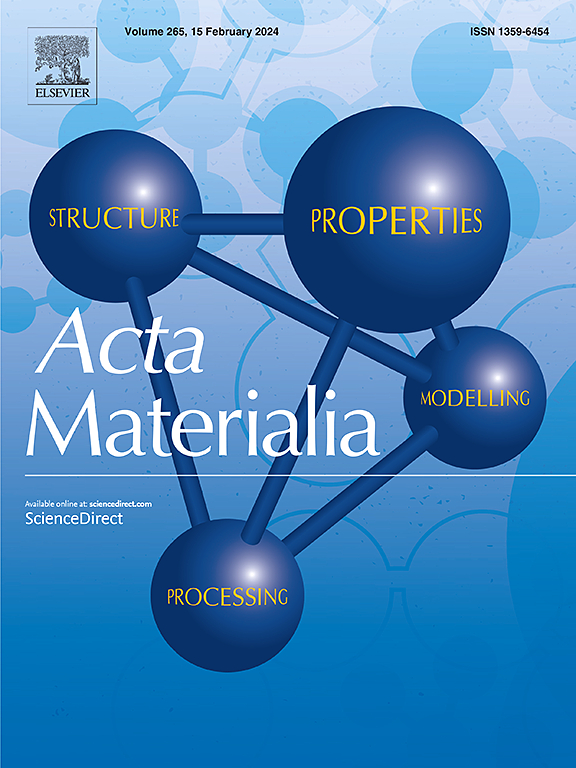超高居里温度下新型RuO2(MgF)2和RuO2(ZnF)2铁谷半导体的自旋和谷极化
IF 8.3
1区 材料科学
Q1 MATERIALS SCIENCE, MULTIDISCIPLINARY
引用次数: 0
摘要
具有自旋和谷极化的二维室温铁谷半导体在下一代高速低功耗信息技术中具有巨大的潜力。通过第一性原理计算和蒙特卡罗模拟,我们发现具有可行性的RuO2(MgF)2和RuO2(ZnF)2单层膜正是这种极其稀缺的候选材料。RuO2(MgF)2和RuO2(ZnF)2均为伊辛型铁磁体,居里温度分别为1084 K和972 K。由于自旋轨道耦合和面外铁磁性的相互作用,六方RuO2(MgF)2/RuO2(ZnF)2基序在其最上面的价带自发产生了195/194 meV的超净谷极化,这进一步得到了四波段k⋅p模型的证实。更重要的是,这两种材料在空穴掺杂和实验范围内的双轴应变下都保持了rt - Ising以上的铁磁体。在这两种体系中,通过掺杂适度空穴和施加面内电场的红外光照射,都可以自然地实现反常谷霍尔效应。此外,我们发现自旋和谷极化可以通过压缩应变和磁化翻转反转。这些突出的特性揭示了RuO2(MgF)2和RuO2(ZnF)2在应变电子学,自旋电子学,谷电子学,光电子学及其集成方面的广泛潜在应用的巨大潜力。本文章由计算机程序翻译,如有差异,请以英文原文为准。

Spontaneous spin and valley polarizations in novel RuO2(MgF)2 and RuO2(ZnF)2 ferrovalley semiconductors with ultrahigh Curie temperatures
Two-dimensional room-temperature (RT) ferrovalley semiconductors with spontaneous spin and valley polarizations hold enormous potential in next-generation high-speed and low-power dissipation information technology. By first-principles calculations and Monte Carlo simulations, we discover that the RuO(MgF) and RuO(ZnF) monolayers with viable fabrication are right such extremely scarce candidate materials. In particular, both RuO(MgF) and RuO(ZnF) are predicted to be Ising-type ferromagnets with ultrahigh Curie temperatures of 1084 and 972 K, respectively. Due to the interplay between spin–orbital coupling and out-of-plane ferromagnetism, the hexagonal RuO(MgF)/RuO(ZnF) motif spontaneously produces ultraclean valley polarizations as sizable as 195/194 meV in their topmost valence bands, which are further corroborated by a four-band k p model. More importantly, these two materials remain as above-RT Ising ferromagnets under both hole doping and biaxial strains within experimental reach. The anomalous valley Hall effect can be naturally achieved in both systems through doping moderate holes and infrared light irradiation upon applying an in-plane electric field. Also, we find that the spin and valley polarizations can be inverted via compressive strain and magnetization flipping. These outstanding attributes expose vast potential of both RuO(MgF) and RuO(ZnF) for a broad range of potential applications in straintronics, spintronics, valleytronics, optoelectronics and their integration.
求助全文
通过发布文献求助,成功后即可免费获取论文全文。
去求助
来源期刊

Acta Materialia
工程技术-材料科学:综合
CiteScore
16.10
自引率
8.50%
发文量
801
审稿时长
53 days
期刊介绍:
Acta Materialia serves as a platform for publishing full-length, original papers and commissioned overviews that contribute to a profound understanding of the correlation between the processing, structure, and properties of inorganic materials. The journal seeks papers with high impact potential or those that significantly propel the field forward. The scope includes the atomic and molecular arrangements, chemical and electronic structures, and microstructure of materials, focusing on their mechanical or functional behavior across all length scales, including nanostructures.
 求助内容:
求助内容: 应助结果提醒方式:
应助结果提醒方式:


